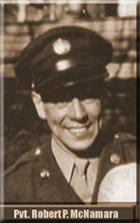
Robert Patrick McNamara — L Company, third battalion, 358th Infantry Regiment, 90th Division
PART 02:
75 Years and Three Generations Later:
D-Day Remembered — A Story of War, Fate and Homage
 It was August 3rd, 2011 when my phone rang at 4:30 in the afternoon. Sixty-seven years after the death of my grandfather, I was about to meet the man who was with him the night he died. On the other end of the line was Bill Rhodes, a soldier who had been in training with my grandfather in England and who had landed in Normandy with him as part of the D-Day invasion. Not only had they traveled together during the final weeks of my grandfather’s life, Bill had also been immediately next to him when Robert was killed by a mortar shell on that fateful night of July 7th, 1944 on Hill 122.
It was August 3rd, 2011 when my phone rang at 4:30 in the afternoon. Sixty-seven years after the death of my grandfather, I was about to meet the man who was with him the night he died. On the other end of the line was Bill Rhodes, a soldier who had been in training with my grandfather in England and who had landed in Normandy with him as part of the D-Day invasion. Not only had they traveled together during the final weeks of my grandfather’s life, Bill had also been immediately next to him when Robert was killed by a mortar shell on that fateful night of July 7th, 1944 on Hill 122.
I’d been researching my family history for years, looking for clues about my grandfather and his family when I came across a series of war memoirs posted online telling the story of L Company, Third Battalion, 358th Infantry Regiment, 90th Division. Daniel Sheridan, the son of Private Alfred Sheridan, had created the site in honor of his father and had given my phone number to Bill Rhodes after I’d inquired about my grandfather. Bill was 93 years old at the time and one of the few remaining survivors of Company L.
A call from Bill Rhodes - A Friend and Veteran of McNamara
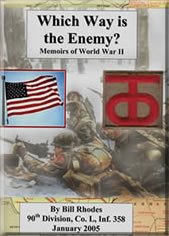 "Hello, is this the granddaughter of Private Robert Patrick McNamara?” Bill asked when I answered the phone. A series of remarkable conversations ensued, where I received a first-hand account of my grandfather’s final months, weeks, and moments of life.
"Hello, is this the granddaughter of Private Robert Patrick McNamara?” Bill asked when I answered the phone. A series of remarkable conversations ensued, where I received a first-hand account of my grandfather’s final months, weeks, and moments of life.
Bill Rhodes and Robert McNamara met in England, and they went through several months of training together before pitching a tent on the downward slope of a hill overlooking the English Channel. When it was time to attack the Germans in Normandy, they climbed down rope ladders from a larger ship into a boat, side by side. They were part of Company L of the famous 90th Division, who in the span of just over a month, would only have 27 men left on the battlefield from their original group of 200. By July 15th, 1944 they would tragically lose nearly 90% of their men.
Just before the D-Day invasion, they’d been sleeping eight men to a tent on cots. Water was scarce. According to Peragimus: A Brief History of the 358th Infantry, daily the men were required to carry full combat equipment on fast road marches. In April, my grandfather had written home that each soldier had a “canteen cup of water to take a bath in and that guys pay five cents to bathe.” Bill Rhodes recalled, “They only gave us half portions to eat. We looked for English teahouses to get bread and tea at night because we were so hungry.”
“We rode the train from camp to the boat and each of us got bullets. Then we realized we were going to war,” Rhodes shared with me during one of our many phone calls. “We didn’t think we’d go to war so soon. We landed on Utah Beach together in assault boats on June 8th, also known as D-Day Plus 2. After landing we dropped our packs, never to see them again. There was no way of knowing if you’d be alive the next day.”
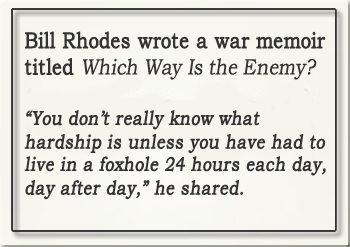 Bill Rhodes wrote a war memoir titled Which Way Is the Enemy? Memoirs of World War II, where he recounted walking single file towards the enemy lines in June 1944. “It was so dark I could scarcely make out the shadowy outline of the soldier ahead of me,” he wrote. Aside from the enemy, he described how combat soldiers had three major problems to deal with: fear, exhaustion and cold, wet feet. “You don’t really know what hardship is unless you have had to live in a foxhole 24 hours each day, day after day,” he shared.
Bill Rhodes wrote a war memoir titled Which Way Is the Enemy? Memoirs of World War II, where he recounted walking single file towards the enemy lines in June 1944. “It was so dark I could scarcely make out the shadowy outline of the soldier ahead of me,” he wrote. Aside from the enemy, he described how combat soldiers had three major problems to deal with: fear, exhaustion and cold, wet feet. “You don’t really know what hardship is unless you have had to live in a foxhole 24 hours each day, day after day,” he shared.
By June 24th, long-awaited replacements had finally arrived. A few days later, Robert wrote one of his final letters. “Hi Angel, Here’s your hubby again. When I get home I want to have steak, mushrooms, shrimp salad, strawberry shortcake with all the whipped cream I can eat and good coffee… I kiss your picture goodnight every night no matter where I am. Keep smiling dear and don’t worry, I’ll be ok. I’ll dream of you tonight.”
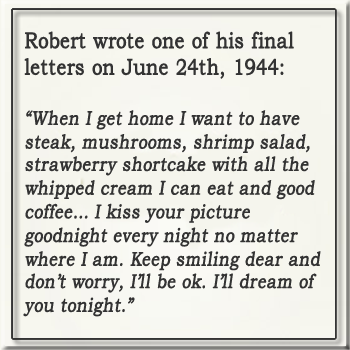 The Battle of Hill 122
The Battle of Hill 122
On July 4th Pvt. Bill Rhodes and my grandfather walked down a steep embankment across railroad tracks, lining up along a first hedgerow facing the enemy. The famous hedgerow country of Normandy brought forth bitter hedge to hedge combat, with each hedge forming another line of defense. The rains had begun falling, with damp, dismal weather prevailing. “The enemy clobbered us with mortar shells,” Rhodes wrote in his memoir. He remembered a mortar shell nearly killing him. If it had landed two feet to the left, it would have been him who was hit.
>> See Part 3 to Article by Deborah McNamara
Robert P. McNamara >> Part 02 | Part 03 | Part 04 | Part 05 |
Written by Deborah McNamara
Writer, sustainability activist, and author in Boulder, Colorado. Learn more at www.DebMcNamara.com
Click Link Below to Read Article by Deborah McNamara - on Medium.com
75 Years and Three Generations Later:
D-Day Remembered — A Story of War, Fate and Homage

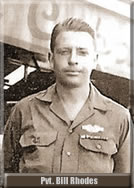 Click here
Click here Click here
Click here